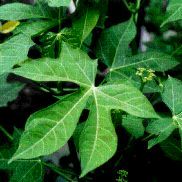Cnidoscolus chayamansa
Chaya, Tree spinach, Chaya col, Kikilchay, and Chaykeken
Tropical

Introduction
Chaya is a large, fast growing leafy perennial shrub reaching a height of about 2-3 meters (6-9 feet). It somewhat resembles a vigorous hibiscus plant or the cassava plant. Probably native to the Yucatan Penninsula of Mexico, Chaya leaves are used as a green vegetable to some extent from Mexico to Brazil. The genus Cnidoscolus consists of 40 or more species, but only chayamansa refers to the vegetable chaya.
Pros
- Unlike many leaf crops with a short season, chaya leaves can be harvested continuously (but not more than half the foliage should ever be harvested at one time or later growth will be greatly slowed).
- Chaya makes an excellent shrub in the yard or a hedgerow that can be continuously pruned for a large supply of vegetable greens from otherwise unproductive land.
- Very productive, can produce 8-10 tons of nutritious greens per hectare (c.2.5 acres)
- Very easy to grow needing little care and not much bothered by pests
- Tolerant of heavy rain and has some drought tolerance
- Relatively rich in protein, iron, carotene and vitamin C
Cons
- ** Raw chaya leaves are poisonous. They contain a high content of a glucoside that can release toxic hydrocyanic acid. In this respect chaya is similar to cassava. With chaya, 1 minute of boiling destroys most of the acid. When drying chaya leaves it is best to blanch the leaves in boiling water for 3 minutes then rinse in clear water before drying or to grind the leaves first and dry the pulped leaves. This will make them safe to eat.
- Very sensitive to frost
- Some varieties (especially the closely related wild Cnidoscolus aconitifolius) have stinging hairs and require gloves for harvest. The sting is removed by cooking or grinding. Several improved varieties have leaves that don't sting.
- Susceptible to fungal infection on fresh wounds.
Notes
- Chaya produces seed about the size of a walnut, but is usually propagated by woody stem cuttings about 6-12 inches long.
- They root slowly especially if the soil is not well drained.
- Chaya leaves shouldn't be harvested until the second year.
- Plants should be at least 3 meters (10 feet) apart.
- A bucketful of well rotted manure or compost mixed into the soil before planting greatly improves leaf production.
- Can grow to be 5 meters (16 feet) tall, but are usually pruned to half of that for easier leaf harvest.
- There is a large variation in the flavor of chaya greens, with the variety called 'Pig Chaya' given the best rating, especially when served with butter and salt.
- Typically used in soups, atoles (thick hot corn drinks),and omelets with onions.
Seeds
- Usually grown from locally obtained stem cuttings
- It is sometimes possible to get cuttings from:
ECHO?
17391 Durrance Rd.
North Fort Myers, Fl 33917 USA
fax 941–543–5317
Related Plants with Edible Leaves
Cnidoscolus aconitifolius; Manihot esculenta (cassava); Sauropus androgynus (katuk)